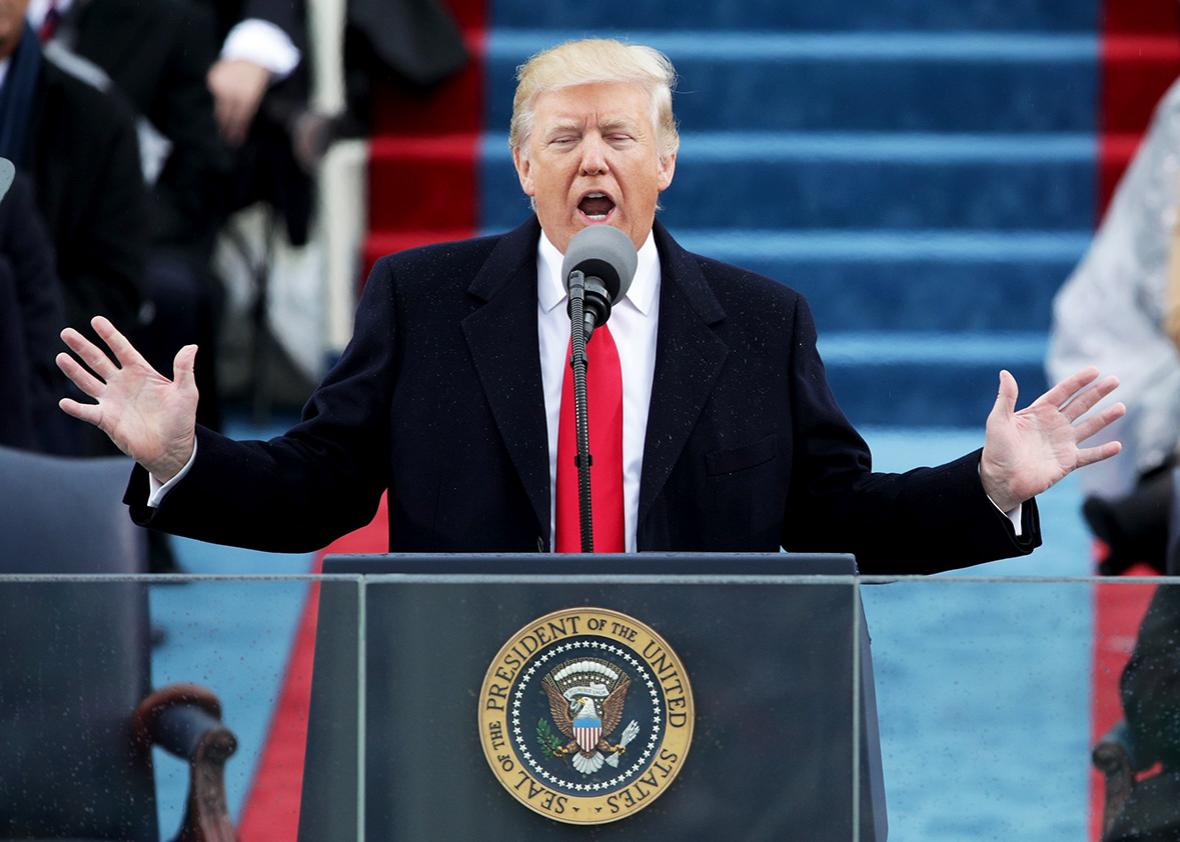In his inaugural address, Donald Trump promised to save America from a hellish wave of crime and disorder. “The crime and the gangs and the drugs that have stolen too many lives and robbed our country of so much unrealized potential,” said the president. “This American carnage stops right here and stops right now.”
There’s a small problem with this image. It’s a fantasy. And it’s a fantasy that serves a particular purpose: to demonize groups and protest movements organized around police reform. The evidence is the White House page on law enforcement, updated after Trump’s inauguration. “Our job is not to make life more comfortable for the rioter, the looter, or the violent disrupter,” writes the administration on a page titled “Standing Up for Our Law Enforcement Community.” But this isn’t demonization for its own sake; it’s central to the president’s larger political vision, a white identity politics that looks with skepticism and hostility toward claims of racial injustice.
First, a few facts. It is true that, from 2014 to 2015, the overall number of violent crimes increased by nearly 4 percent, including a 10.8 percent increase in the homicide rate. It’s true that this increase was concentrated in the nation’s 50 largest cities, where 770 more people were killed in 2015 than the previous year, a 17 percent increase and the worst annual change since 1990. And it’s also true that this was concentrated in a handful of cities, most notably Baltimore, Chicago, and Washington.
As bad as it is, however, this increase belies the larger picture: Americans are safer now than at any point since the 1960s. “Overall crime rates in 2016 are projected to be nearly the same as last year, with crime remaining at an all-time low,” concludes an early analysis from the Brennan Center for Justice. Violent crime is less than half as prevalent as it was in 1991, when it peaked at 758 offenses per 100,000 residents. Homicides, likewise, are less than half of what they were in the 1980s and 1990s. Violent crime mars too many communities, but the overall picture is of progress, not disorder.
Trump’s rhetoric doesn’t match reality. There is no broad “American carnage.” But one group does bear the brunt of violent crime: black Americans, who are most likely to live in the kinds of impoverished, segregated neighborhoods that produce criminals and victims. At the same time, black Americans are most critical of law enforcement and broadly supportive of movements and policies to reform policing. Just 35 percent of black Americans believe their local police treat “racial and ethnic groups equally,” and 31 percent think officers are held accountable when “misconduct occurs.”
These facts are critical to grasping the politics of Trump’s rhetoric on “law and order.” Neighborhood safety and police accountability aren’t in tension with each other. Effective police departments are those that don’t tolerate misconduct and that open pathways for officers and communities to work with each other. Indeed, there’s evidence that violent crime is exacerbated by police who eschew accountability; without trust, it’s difficult to solve violent crime, which gives violent criminals space to act and operate with impunity. It’s no coincidence that the Chicago Police Department—blasted for a “pattern or practice of excessive force” in a scathing report by the Department of Justice in the last days of the Obama administration—has a homicide clearance rate in the low 20s.
A Trump who was genuinely interested in reducing crime would see Black Lives Matter and other groups as partners, not adversaries. He would focus less on protecting the reputation of law enforcement and more on ensuring that police act with fairness. And he wouldn’t nominate a candidate for attorney general, Alabama Sen. Jeff Sessions, whose history is marked with disdain for and hostility toward civil rights.
But that’s not the Trump we have. The Trump we have understands that millions of white Americans, including much of his voting base, are profoundly alienated by black protest movements against abusive police. The numbers tell the story. Supermajorities of whites see police as essentially above reproach. Seventy-five percent say they “use the right amount of force for each situation” and believe they “treat racial and ethnic groups equally.” Seventy percent believe police are held accountable for misconduct, and 81 percent say they have either “some” or “a lot” of confidence in their local police departments. In terms of Trump’s supporters, 59 percent of white Republicans believe “too much attention” is paid to race. Perhaps the most revealing number is this one: Just 14 percent of white Americans “strongly support” Black Lives Matter (26 percent support it “somewhat”). If public opinion is any indication, most white Americans simply don’t see the problem. What they do worry about is crime. And Trump is using that fear to undermine the drive to reform law enforcement, and he’s doing it by tying protest to disorder and evoking a highly racialized vision of the violent, crime-ridden “inner city.”
How should we understand President Trump’s pledge to stop so-called American carnage? We should understand it as part and parcel of the white racial nationalism that fueled his campaign, informed his administration, and now shapes his rhetoric as president. It’s a declaration that he will govern with the same eye toward division and racial antagonism he had as a candidate.
